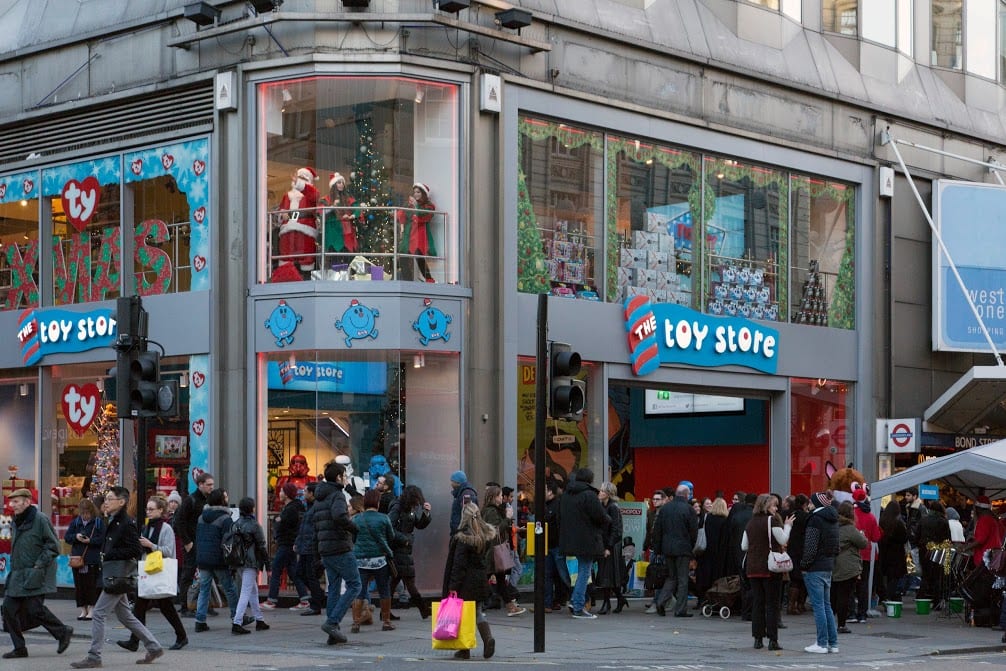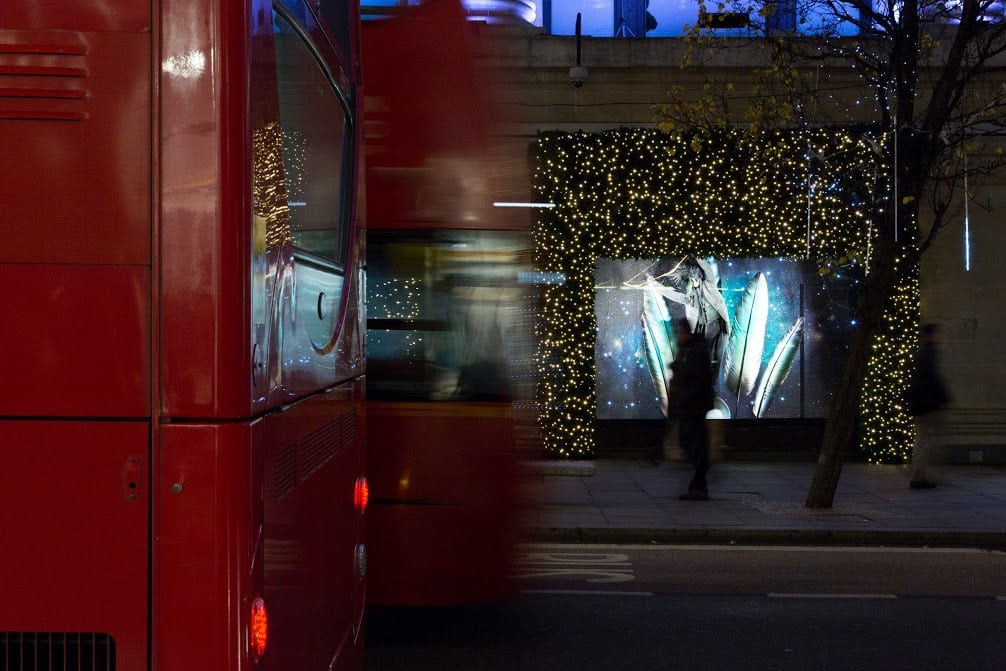Christmas shopping on Oxford Street
By the Survey of London, on 18 December 2015
The Survey of London not only records the architectural history and development of each area that we work on, but draws out the character of that area both in the past and as it has become today. In Oxford Street that character is defined above all by its shops, and Christmas is its busiest time of the year. A couple of weeks ago we asked Lucy Millson-Watkins to photograph the lights, sights and decorations of Christmas on Oxford Street in 2015. Here follows a selection of the photographs that she took, with a few views from the 1950s on the same theme, showing how much – or how little – things have changed.

Oxford Street at dusk, looking east. Photographed in December 2015 (© Survey of London, Lucy Millson-Watkins). If you are having trouble viewing images, please click here.
The throngs of traffic and shoppers at this time of the year have been newsworthy for well over a century. In December 1882 The New York Times commented on the streets in the West End being more than usually crowded, the shops and stores full of ‘wonders of nature and art, sweetmeats and fruits from every clime, toys and magic surprises of all imaginable shapes and inventions, Christmas cards designed by famous pencils, books for children that are art treasures’. [1]

Gather round to get your hands on Cliff Richard. Customers searching through racks of LPs in Selfridges, Christmas 1959. A ‘Cliff Sings’ (Cliff Richard) record can be seen advertised above one of the boxes. (© Henry Grant Collection/Museum of London)

The Toy Store, a Dubai-based chain which opened its first UK flagship store in 2014 close to Bond Street Station. Photographed in December 2015 (© Survey of London, Lucy Millson-Watkins)

West end of Oxford Street looking towards Marble Arch, with Marks & Spencers flagship store. Photographed in December 2015 (© Survey of London, Lucy Millson-Watkins)
‘Christmas shops’ within the larger department stores are also nothing new. In 1909 Warings on Oxford Street created a display which aimed to make the task of choosing a Christmas gift comparatively easy by arranging ‘practically on one floor, suitable articles from their various departments … Silver, lace, bronze, clocks, glass and china, pictures, musical instruments, furniture and fancy articles of every description.’ [2] Not to be outdone, the following year Peter Robinsons was advertising ‘Arcadia’ its ‘grand xmas bazaar’: ‘don’t let the children miss it’. [3]

Boots, with understated decoration. Photographed in December 2015 (© Survey of London, Lucy Millson-Watkins)

Selfridges in December 1953 also making use of the first-floor space above the entrance. Extravagant and elaborate window and exterior displays at Christmas time and during Royal celebrations have been a tradition at Selfridges since the founder Henry Selfridge first lit the shop windows at night for passers by to see goods on sale in 1890. Here statues of Father Christmas and Disney characters stand above the entrance to the store to entice customers inside to look at the Toy displays. (© Henry Grant Collection/Museum of London)
There are grumbles about how early in the year decorations and displays of Christmas gifts appear in the shops, but it seems even that is not new. According to The New York Times, in the mid 1920s Christmas shopping was unthinkable in the United States before Thanksgiving, and it was not really until mid-December that ‘the Christmas fever germ begins to “take” in America’. By contrast, in London ‘everything from orchids and knitting needles to vintage wines and bath salts may be purchased on the afternoon of Armistice Day’ and packages for India and the Far East were posted out soon afterwards. [4] Perhaps therein lies a part of the explanation for our unseasonably early habits.

South side of Oxford Street, looking East. Photographed in December 2015 (© Survey of London, Lucy Millson-Watkins)
During the Second World War the blackout, and later rationing, had obvious effects, as also did bomb-damage – notably on John Lewis’s. On the run up to the first Christmas of the war there was a proposal to erect a light-proof arcade along Oxford Street for night-time window shopping. It was to have comprised a thick solid roof, stretching out over the curb, and heavy canvas screens which could be drawn aside during the day. As yet, we have not discovered if the arcade was built. [5]

Selfridges window display. Photographed in December 2015 (© Survey of London, Lucy Millson-Watkins). Selfridges’ displays this year are themed on the signs of the zodiac, promoting high fashion and accessories much in the same way as Bourne & Hollingsworth were doing in the 1950s.

Window shopping at Bourne and Hollingsworth department store, Christmas 1953. The store opened in 1902 at 116-118 Oxford Street. It became known for the high quality of the goods sold there. The department store closed in the 1980s and the building now houses the Plaza Shopping Centre. (© Henry Grant Collection/Museum of London)
After the war things slowly returned to normal. In 1949 although turkeys were scarce, coconuts made their appearance in the shops for the first time since the war. There were dense crowds of shoppers in Bond Street and Oxford Street, restaurants and hotels reported record bookings at gala dinners, but the main attraction was the giant Christmas tree in Trafalgar Square, the gift of Norway: ‘its coloured lights, surrounded by floodlit fountains, make a picturesque spectacle’. [6]

Selfridges window display. Photographed in December 2015 (© Survey of London, Lucy Millson-Watkins). The windows this year are aimed firmly at adults, though in the past they were more likely to be designed to appeal to families and young children.

Crowds outside Selfridges’ window based on Gulliver’s Travels. Christmas windows were often designed to appeal to children, with ingenious automata. Christmas window display at Selfridges in December 1953. A mannequin cast as Gulliver is used to advertise the third floor toy department and entice customers into the store. The mannequin was automated and his hand and head moved. (© Henry Grant Collection/Museum of London)
‘All gay for the Christmas season’ announced the South China Sunday Post Herald in December 1959. This was the first year that Oxford Street was adorned with decorations running from one end to the other: ‘symbolic Christmas trees, hung with tinsel and lit with coloured bulbs’ ornamented the lamp standards down the centre of the street. [7]

London buses and Selfridges. Photographed in December 2015 (© Survey of London, Lucy Millson-Watkins)
Lights had been put up in Regent Street in 1954, and in the following year some of the Oxford Street stores applied to extend the decorations to include Oxford Circus but Marylebone Council would not allow it because of the possibility, however slight, of an accident. The Council also banned decorations suspended between buildings.

Lights strung across streets have been a feature on Oxford Street since at least 1962, though resisted at first by the local council. Photographed in December 2015 (© Survey of London, Lucy Millson-Watkins)
The stores kept applying, with a more ambitious scheme in 1958 for an ‘Archway of Light’ all along Oxford Street from St Giles’ Circus to Marble Arch (excluding Oxford Circus), but this too was turned down. One of the problems was the traffic chaos, but the Council’s fears of a decoration-related accident proved sadly well founded when early on New Year’s Day a man walking past the Cumberland Hotel in Oxford Street had an unfortunate encounter with a falling 20ft-high revolving Christmas decoration. [8]

Shimmering light, Oxford Street impressions. Photographed in December 2015 (© Survey of London, Lucy Millson-Watkins)
Sources
- New York Times, 4 Jan 1882, p.2
- The Observer, 5 Dec 1909, p.17
- The Observer, 20 Nov 1910, p.18
- New York Times, 13 Dec 1925, p.24
- The Sun, Baltimore, 7 Dec 1939, p.14
- South China Sunday Post, 25 Dec 1949, p.7
- South China Sunday Post Herald, 20 Dec 1959, p.22
- The Times, 27 May 1957, p.6; 20 Dec 1958, p.6; 7 Jan 1959, p.4
2 Responses to “Christmas shopping on Oxford Street”
- 1
-
2
Seasons Greetings from the Survey of London | UCL The Survey of London wrote on 21 December 2018:

[…] Oxford Street. Here is a selection of the photographs that she took, first published online in a blog post that considered the festive season on Oxford Street and its enduring traditions. The […]
 Close
Close



[…] Street in 2015. Here is a selection of the photographs that she took, first published online in a blog post which considered the festive season on Oxford Street and its enduring […]